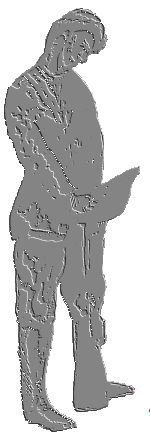 |
THE FAME OF TIPPERARY GROUP
ETHOS & ORIGINS |
 |
THE ORIGINS OF "THE FAME OF TIPPERARY GROUP"
"THE FAME OF TIPPERARY GROUP" WAS FOUNDED IN TIPPERARY TOIWN DURING 1998 WITH THE AIM OF REMEMBERING AND ACKNOWLEDGING THE SERVICE OF IRISH MEN AND WOMEN WHO WORE UNIFORM AND WERE INVOLVED IN WORLD CONFLICTS OF THE NINETEENTH AND TWENTIETH CENTURIES. THE F. O. T. G. ARE INTERESTED IN PRESERVING THE LOCAL HISTORY OF COUNTY TIPPERARY, IN PARTICULAR ITS MILITARY HISTORY. THE FIRST WORLD WAR SONG "IT'S A LONG WAY TO TIPPERARY" IS WORLD FAMOUS, YET THE LOCAL MEN WHO FOUGHT IN THAT WAR ARE MOSTLY FORGOTTEN IN THEIR HOMELAND. THE F.O.T.G. DECIDED IN 1999 TO CREATE A VIRTUAL MUSEUM AND ROLL OF HONOUR IN CYBERSPACE TO HONOUR THOSE ASSOCIATED WITH COUNTY TIPPERARY WHO SERVED AND DIED. AFTER TWO YEARS' RESEARCH & CREATION, THIS WEBSITE WAS LAUNCHED IN JULY 2001. THIS MONTH WAS THE 80th. ANNIVERSARY OF THE ANGLO-IRISH TRUCE OF 1921 AND THE 85th. ANNIVERSARY OF THE FIRST WORLD WAR BATTLE OF THE SOMME. IN THAT BATTLE, IRISHMEN OF ALL BACKGROUNDS FROM ALL 32 COUNTIES OF IRELAND FOUGHT AND DIED ALONGSIDE ONE ANOTHER AS COMRADES IN THE DEFENCE OF FREEDOM IN EUROPE. IN PARTICULAR, THE FAME OF TIPPERARY GROUP WISH TO HONOUR "THE IRISH IN UNIFORM" WHO, DURING THE FIRST WORLD WAR, ENLISTED TO MILITARY AND NURSING SERVICES FROM THE 26 COUNTIES OF WHAT IS NOW THE REPUBLIC OF IRELAND.
In 1966, the 50th anniversary of the
1916 Rising, the Irish Taoiseach SEAN LEMASS said:
"In
later years it was common - and I was also guilty in this respect
- to question the motives of those men who joined the new British
armies formed at the outbreak of the war, but it must in their
honour and in fairness to their memory be said that they were
motivated by the highest purpose."
More about The Fame of Tipperary
Group further down
this page >>>

"Marching unto war"
Image based on a photograph of the men of "The Liverpool Irish" advancing at La Boisselle, during The Battle of Albert, 1st. July 1916. © The WebWizards at The Plug-in Office July 2001.
The First World War was the first mechanised war and was fought between industrialised nations. For the first time, cavalry became outdated and mechanised armoured tanks became used. Submarines were invented and put into service, aircraft and airships were used to deliver bombs from the skies; gas attacks became a new horror for armies to endure. In previous conflicts, brief skirmishes and short battles were the norm of warfare; even seiges were comparitively brief and ended in a few weeks or months. The stalemate of trench warfare in North-Eastern France and Flanders (Belgium) lasted for several years, shattering the hopes of career soldiers and optimistic new recruits who had expected the war "to be over by Christmas" (1914). Huge numbers of men were killed, injured or captured in advances during which only very small amounts of ground were gained control of - only to be lost again soon afterwards in counter attacks. The tide of war ebbed and flowed relentlessly back and forth over the fields of Flanders until the devastated landscape was rendered unrecognisable. The scars of war are still visible there today. For the first time in the history of warfare, even the graves of the fallen were destroyed by bombardments from heavy artillery and aircraft. Thousands of men dissappeared without trace on the battlefields and many corpses were unidentifiable. In some cases, their regiments and units could be estimated because of when and where they fell; but, in the chaos Twentieth Century warfare, even that information remained unreliable. The poet Rudyard Kipling, whose own son was killed serving with The Irish Guards, coined the phrase "Known only unto God", which appears on many war memorials and graves dedicated to unidentified soldiers, sailors and airmen. A whole generation of young men was decimated by the carnage.
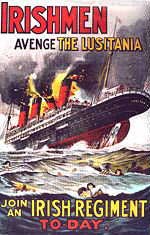
In Ireland, many young men answered the call to arms and joined The British Army as volunteers. Conscription was never introduced on the island of Ireland. When the British Government were considering introducing it in 1918, protests were raised in all the 32 counties and the matter was dropped. Therefore, every Irishman who served in the British armed forces did so as a volunteer. Some joined up following the urging of John Redmond, hoping that Ireland would be given Home Rule after the war, after demonstrating that Ireland was worthy of it because Irishmen could contribute as much to The Empire and its defence as the men of Canada, New Zealand and Australia; countries which already had Home Rule within it at that time.
Thus, Protestant Ulstermen joined up to fight to preserve Britain; as it was then, and Catholics from Ireland's other three Provinces joined up because they hoped to achieve Home Rule and then a seperate Irish nationhood afterwards. After the massive slaughter of the regular regiments of career soldiers during 1914/1915 , the huge losses of the abortive Gallipoli campaign in Turkey and the extension of the war into other areas such as Italy and The Middle East; by 1916 the troops fighting in France and Belgium were becoming fragmented and fewer in number. By the time The Battle of the Somme began on 1 July 1916, it had been necessary to transfer soldiers to other units and to merge regiments. The 36th. (Ulster) Division and the 16th. (Irish) Divisions fought during that battle side by side - Northern and Southern Irish together, Protestants and Catholics alongside one another - putting aside all rivalries in the common goal of achieving freedom for Europe by stopping the armed forces of The Central Powers from seizing and maintaining power over the countries they had invaded in 1914. Those forces, if they were not vanquished, threatened to invade the islands of Britain and Ireland and subjugate them as they had invaded Belgium and France and attempted to put them under occupation.
Those of us now living on the entire island of Ireland owe our present freedoms and prosperity to the service and sacrifice of the young men from across the widespread countries of the former British Empire who fought and died from 1914 to 1918 in what became known as "The War To End All Wars". They came from India, Canada, New Zealand, Australia, Fiji, Africa, England, Scotland, Wales and Ireland to the battlefields of Europe, Asia Minor and North Africa. Sadly, the service, heroism and sacrifice of` the young men who joined up from what are now the 26 counties which later became The Irish Republic, became pushed out of memory by the events which took place in their homeland from 1916 onwards, resulting in The Irish Civil War and the creation of The Free State.
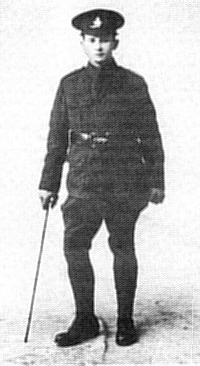 |
A young soldier of the 8th. (Irish) Battalion of The King's Liverpool Regiment "The Liverpool Irish" 1915. This fresh-faced young Irish lad proudly posing in his uniform would soon encounter the harsh reality of trench warfare and the misery of wet, cold conditions for months on end, never knowing when he would meet his fate. Many young men deceived the Recruiting Sergeants and joined up when they were 'under-age', often dying in combat when they were still under the official age limit for military service. When they joined the army, they saw war as a great adventure, which took them away from home for the first time and gave then an opportunity to 'see the world'. Sadly, thousands upon thousands were never to return home. The postcards and letters they sent home were in the main cheerful, glossing over the horrors of trench warfare so as not to worry their loved ones. |
| In reality, they endured cold, wind, rain, snow, and mud. Food was often cold and rations short. Short of sleep, they endured constant noise, stress and discomfort in the trenches; and sheer terror when ordered "over the top" into open ground for an attack. They were shelled by heavy artillery, gassed, harried by snipers, strafed and bombed from the skies. Some drowned or were suffocated by mud after slipping and falling into shell holes whilst carrying heavy equipment. Others died of exhaustion, hyperthermia, shock or disease. Often, they were in the company of the corpses of their dead comrades for days on end before those could be buried. They saw rats eat their friends and gassed corpses turn green. Those who returned home after the war rarely spoke of their traumatic war experiences, preferring to forget the horrors they had experienced in what the poets dubbed "a living hell". | 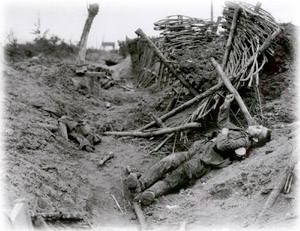 The body of a young soldier lying in a ruined trench at Messines Ridge, Ypres, Belgium |

|
This quotation from a F.O.T.G. spokesman appeared in local newspapers in reply to severe criticism of the group's aims in 1998. "We make no apologies to anyone for our efforts to provide for Tipperary a resource which will depict the horrors of war and emphasize the importance and necessity for peace both in Ireland and throughout the World. We leave it to the judgment of the people in Tipperary Town and district to decide if this project should go ahead..... we would not feel competent to judge in the clear light of hindsight the motivations of those Irishmen who for whatever reason, rightly or wrongly, fought in The Great War. We leave their memory to the judgment of history. Among those who participated and survived to play a major role in the War of Independence were General Tom Barry. . . and Brigadier Emmet Dalton, to name but two." Captain Paddy Keane of 2nd. Battalion, 3rd. Tipperary Brigade, served in the British Army from 1914 to 1918. After "The Great War" ended, he joined the old I.R.A., and saw active service in The Irish War of Independence. After the signing of The Treaty in 1921, he took the pro-Treaty side and became a captain in The National Army. |
|
| The Fame of Tipperary Group are currently researching World War 1, particularly with respect to the 1914-1918 war service of men and women from County Tipperary or born into Tipperary families overseas. They are also researching the local life of the families and men of Army Regiments which were quartered in Tipperary Town Barracks from 1837 onwards, The Fight for Irish Freedom 1916-1948 and the service of women in uniform, from Cumann na mBan to nurses in all Twentieth Century wars - all with particular regard to those from County Tipperary. Please contact the Group by sending a letter to The Fame Of Tipperary Group if you have any historical information or photographs which may be relevant to our researches, or comments on this website. (Photographs & artifacts will be scanned and the originals returned to the owners). Please indicate clearly in writing if you are granting permission for any facts you send to be put onto the website,or if you wish any to be excluded. The F.O.T.G., by creating and hosting this website, aim to honour the service and sacrifice of Irish men and women in areas of history previously eclipsed by later events, by collating as much material as possible and making the information available to all worldwide via this Internet information resource. | |
To contact the FOTG, write to "The Fame of Tipperary Group", c/o 20 Davis Street, Tipperary Town, County Tipperary, Republic of Ireland; or e-mail the members below. |
|
| The F.O.T.G. | tipperaryfame@eircom.net |
Larry Creamer |
|
Denis Hartnett |
|
| WebCrafter | jayrufus@yahoo.co.uk |
Noreen Higgins |
|
THIS WEBSITE IS DEDICATED TO THE 16th. IRISH DIVISION
"LEST WE FORGET"
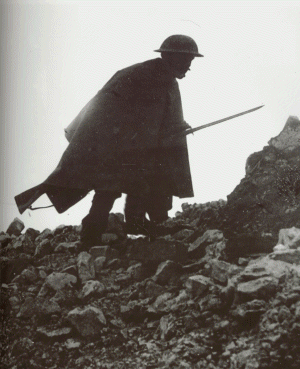
Photo of a soldier of The Irish Guards, taken on the battlefield by Father Frank Browne S. J., the Regimental Chaplain. Fr. Browne was awarded the Military Cross and the French Croix de Guerre medals during 'The Great War'.